Payments from U.S. cap-and-trade, a carbon tax, or a proposed climate change mitigation mechanism could help end Amazon deforestation in Brazil, reducing CO2 emissions 2-5%, by 2020. But Brazil’s window to act is only 2-3 years, say scientists.
Funds generated under a U.S. cap-and-trade or a broader U.N.-supported scheme to reduce greenhouse gas emissions from deforestation and degradation (“REDD”) could play a critical role in bringing deforestation in the Brazilian Amazon to a halt, reports a team writing in the journal Science. But the window of opportunity is short — Brazil has a two to three year window to take actions that would end Amazon deforestation within a decade.
Analyzing Brazil’s plan to cut Amazon forest clearing by 70 percent over the next decade and current efforts by major Brazilian beef and soy producers to exclude deforesters from the supply chain, Dan Nepstad of the Woods Hole Research Center and colleagues lay out a scenario under which net forest loss in the Brazilian Amazon could fall to zero by 2020. The external cost of the effort would be $7 to $18 billion, or 13-33 percent of what Americans spend annually on diet foods and beverages. Roughly half the payments would go towards establishing a forest peoples’ fund to pay for “community forest-based economic activities, health, education, and cultural preservation for the region’s indigenous, and traditional forest peoples and smallholder farmers.”
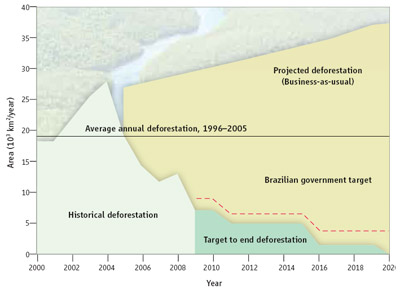
|
Ending deforestation in the Brazilian Amazon would reduce global carbon emissions 2-5 percent, safeguard the planet’s largest reservoir of terrestrial biodiversity, and ensure the continued provision of critical ecosystem services for Brazil and the world. It would also clearly establish Brazil as the leading player in the environmental services market, a sector expected to be worth hundreds of billions of dollars annually in the next 20 years. Brazil’s reduction in emissions from deforestation could alone generate $37 billion to $111 billion between 2013 and 2020 in revenue, some of which could be used to expand the program to end deforestation. Finally, eliminating Amazon deforestation in Brazil would send a powerful message to other countries, showing that it is indeed possible to protect the environment and benefit economically.
“Brazil has a 2-3 year window of opportunity to consolidate its gains in controlling Amazon deforestation,” Nepstad told mongabay.com.
“The political momentum is high today and the drivers of deforestation are still weak, and both of these conditions could change very soon,” he said, noting that Brazil will be holding elections in 11 months and the economy is poised to heat up, raising the prospect of increased demand for commodities produced in the Amazon.
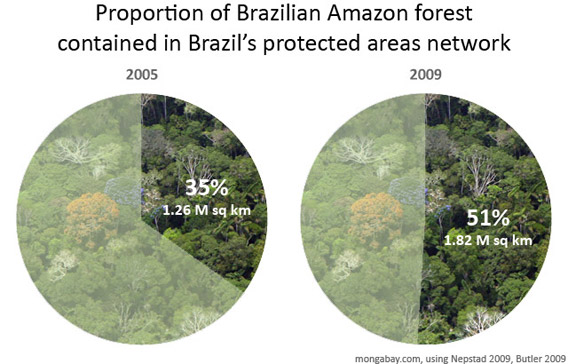
|
“The potential is for Brazil to lock the world into a virtuous circle in which the REDD market grows strong, stimulating greater tropical forest governance (in Brazil and beyond), which feeds the REDD market. There is a huge surge in global demand for grains, beef, biofuel, that will undo the progress made leading up to, and beyond, Copenhagen, unless the important gains achieved thus far are secured.”
While it may seem far-fetched that deforestation in the Brazilian Amazon — the largest extent of rainforest in the world — can actually be halted, the Nepstad and colleagues are encouraged by a number of developments, including a dramatic drop in annual deforestation since 2005; a 50 percent increase in the amount of Brazilian Amazon under protection since 2005; and the emergence of environmental performance as a chief concern among buyers of commodities produced in the Amazon. This shift is perhaps best exemplified by the recent fallout from a June Greenpeace report, which linked illegal deforestation to leather and beef used by major consumer brands and supermarket chains.
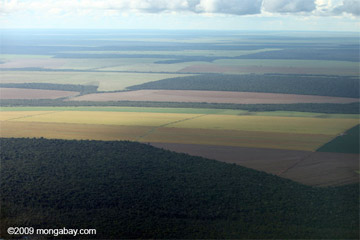 Patchwork of legal forest reserves, pasture, and soy farms in the Brazilian Amazon. Photo by Rhett A Butler |
Days after the report was released, Brazil’s biggest domestic beef buyers, supermarket chains Wal-Mart, Carrefour, and Pão de Açúcar, announced they would suspend contracts with suppliers found to be involved in Amazon deforestation. Bertin, the world’s second largest beef exporter, saw its $90 million loan from the World Bank’s International Finance Corporation withdrawn. Investigators raided the offices of JBS, the world’s largest beef processor, and other firms, arresting executives for corruption, fraud, and collusion. A Brazilian federal prosecutor filed a billion-dollar law suit against the cattle industry for environmental damage, warning that firms found to be marketing tainted meat will be subject to fines of 500 reais ($260) per kilo. Marfrig, the world’s fourth largest beef trader, said it would institute a moratorium on buying cattle raised in newly deforested areas within the Brazilian Amazon (Bertin echoed the moratorium in Augus, followed by JBS in October). BNDES, the development bank that accounts for most financing for the agricultural sector in Brazil, announced it would reform its lending policies, making loans contingent on environmental performance. Government ministers, financiers, and beef buyers called for a certification system that would ensure traceability through the cattle supply chain.
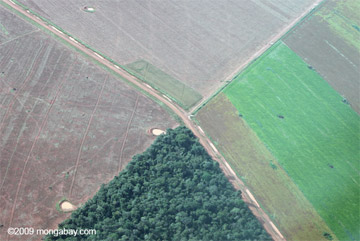 Pasture and legal forest reserve near the Arc of Deforestation in the Brazilian Amazon. Photo by Rhett A Butler |
Such a system is already in existence. It has been developed over several years under an unusual partnership between a maverick Amazon cattle rancher named John Carter (a co-author on the Science paper) and some of the world’s most prominent environmental scientists (several of them also co-authors on the paper). The system, which is administered by Aliança da Terra, a Brazilian NGO run by Carter, is considered by some observers as a critical path towards rewarding environmental stewardship by ranchers and farmers operating in the Amazon while protecting key ecosystem functions of the planet’s largest rainforest.
“Ranchers and soy farmers are seeing the writing on the wall,” said Nepstad during a 2007 interview with mongabay.com. “If they want to sell into the growing international markets for their products, they need to obey the law and adopt sound land stewardship practices.”
“Aliança provides a credible mechanism for this to happen.”
Market recognition — in the form of carbon payments to responsible ranchers and farmers and/or higher prices for certified products — of these efforts is also critical. But compensation will have to expand beyond the “industrial” drivers of deforestation — benefits will have to reach a wide range of stakeholders across the Amazon. Again some models are already in place, including the Bolsa Floresta program in the state of Amazonas, which pays families a monthly stipend and gives them access to healthcare for maintaining forest cover. The scheme has proved so effective that it is already being adopted in other Brazilian states seeking to reduce deforestation.
But all these initiatives require some level of political commitment to ensure their ongoing success. Rooting out corruption, improving governance, improving land tenure systems, and enforcing existing laws will be critical in reducing deforestation in the Amazon in the long-term. Thus the fate of the world’s largest rainforest may depend as much on progress in these areas as it does carbon finance and market-based recognition for environmental performance by ranchers and farmers.
Related articles
Concerns over deforestation may drive new approach to cattle ranching in the Amazon

(09/08/2009) While you’re browsing the mall for running shoes, the Amazon rainforest is probably the farthest thing from your mind. Perhaps it shouldn’t be. The globalization of commodity supply chains has created links between consumer products and distant ecosystems like the Amazon. Shoes sold in downtown Manhattan may have been assembled in Vietnam using leather supplied from a Brazilian processor that subcontracted to a rancher in the Amazon. But while demand for these products is currently driving environmental degradation, this connection may also hold the key to slowing the destruction of Earth’s largest rainforest.
Are we on the brink of saving rainforests?

(07/22/2009) Until now saving rainforests seemed like an impossible mission. But the world is now warming to the idea that a proposed solution to help address climate change could offer a new way to unlock the value of forest without cutting it down.Deep in the Brazilian Amazon, members of the Surui tribe are developing a scheme that will reward them for protecting their rainforest home from encroachment by ranchers and illegal loggers. The project, initiated by the Surui themselves, will bring jobs as park guards and deliver health clinics, computers, and schools that will help youths retain traditional knowledge and cultural ties to the forest. Surprisingly, the states of California, Wisconsin and Illinois may finance the endeavor as part of their climate change mitigation programs.
Brazil’s plan to save the Amazon rainforest

(06/02/2009) Accounting for roughly half of tropical deforestation between 2000 and 2005, Brazil is the most important supply-side player when it comes to developing a climate framework that includes reducing emissions from deforestation and forest degradation (REDD). But Brazil’s position on REDD contrasts with proposals put forth by other tropical forest countries, including the Coalition for Rainforest Nations, a negotiating block of 15 countries. Instead of advocating a market-based approach to REDD, where credits generated from forest conservation would be traded between countries, Brazil is calling for a giant fund financed with donations from industrialized nations. Contributors would not be eligible for carbon credits that could be used to meet emission reduction obligations under a binding climate treaty.
How to save the Amazon rainforest
(01/04/2009) Environmentalists have long voiced concern over the vanishing Amazon rainforest, but they haven’t been particularly effective at slowing forest loss. In fact, despite the hundreds of millions of dollars in donor funds that have flowed into the region since 2000 and the establishment of more than 100 million hectares of protected areas since 2002, average annual deforestation rates have increased since the 1990s, peaking at 73,785 square kilometers (28,488 square miles) of forest loss between 2002 and 2004. With land prices fast appreciating, cattle ranching and industrial soy farms expanding, and billions of dollars’ worth of new infrastructure projects in the works, development pressure on the Amazon is expected to accelerate. Given these trends, it is apparent that conservation efforts alone will not determine the fate of the Amazon or other rainforests. Some argue that market measures, which value forests for the ecosystem services they provide as well as reward developers for environmental performance, will be the key to saving the Amazon from large-scale destruction. In the end it may be the very markets currently driving deforestation that save forests.
Corporations become prime driver of deforestation, providing clear target for environmentalists
(08/05/2008) The major drivers of tropical deforestation have changed in recent decades. According to a forthcoming article, deforestation has shifted from poverty-driven subsistence farming to major corporations razing forests for large-scale projects in mining, logging, oil and gas development, and agriculture. While this change makes many scientists and conservationists uneasy, it may allow for more effective action against deforestation. Rhett A. Butler of Mongabay.com, a leading environmental science website focusing on tropical forests, and William F. Laurance of the Smithsonian Tropical Research Institute in Panama believe that the shift to deforestation by large corporations gives environmentalists and concerned governments a clear, identifiable target that may prove more responsive to environmental concerns.
Future threats to the Amazon rainforest
(07/31/2008) Between June 2000 and June 2008, more than 150,000 square kilometers of rainforest were cleared in the Brazilian Amazon. While deforestation rates have slowed since 2004, forest loss is expected to continue for the foreseeable future. This is a look at past, current and potential future drivers of deforestation in the Brazilian Amazon.
Half the Amazon rainforest will be lost within 20 years
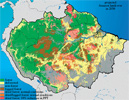
(02/27/2008) More than half the Amazon rainforest will be damaged or destroyed within 20 years if deforestation, forest fires, and climate trends continue apace, warns a study published in Philosophical Transactions of the Royal Society B. Reviewing recent trends in economic, ecological and climatic processes in Amazonia, Daniel Nepstad and colleagues forecast that 55 percent of Amazon forests will be “cleared, logged, damaged by drought, or burned” in the next 20 years. The damage will release 15-26 billion tons of carbon into the atmosphere, adding to a feedback cycle that will worsen both warming and forest degradation in the region. While the projections are bleak, the authors are hopeful that emerging trends could reduce the likelihood of a near-term die-back. These include the growing concern in commodity markets on the environmental performance of ranchers and farmers; greater investment in fire control mechanisms among owners of fire-sensitive investments; emergence of a carbon market for forest-based offsets; and the establishment of protected areas in regions where development is fast-expanding.
Can cattle ranchers and soy farmers save the Amazon?
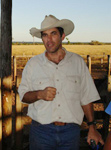
(06/06/2007) John Cain Carter, a Texas rancher who moved to the heart of the Amazon 11 years ago and founded what is perhaps the most innovative organization working in the Amazon, Alianca da Terra, believes the only way to save the Amazon is through the market. Carter says that by giving producers incentives to reduce their impact on the forest, the market can succeed where conservation efforts have failed. What is most remarkable about Alianca’s system is that it has the potential to be applied to any commodity anywhere in the world. That means palm oil in Borneo could be certified just as easily as sugar cane in Brazil or sheep in New Zealand. By addressing the supply chain, tracing agricultural products back to the specific fields where they were produced, the system offers perhaps the best market-based solution to combating deforestation. Combining these approaches with large-scale land conservation and scientific research offers what may be the best hope for saving the Amazon.
Globalization could save the Amazon rainforest

(06/03/2007) The Amazon basin is home to the world’s largest rainforest, an ecosystem that supports perhaps 30 percent of the world’s terrestrial species, stores vast amounts of carbon, and exerts considerable influence on global weather patterns and climate. Few would dispute that it is one of the planet’s most important landscapes. Despite its scale, the Amazon is also one of the fastest changing ecosystems, largely as a result of human activities, including deforestation, forest fires, and, increasingly, climate change. Few people understand these impacts better than Dr. Daniel Nepstad, one of the world’s foremost experts on the Amazon rainforest. Now head of the Woods Hole Research Center’s Amazon program in Belem, Brazil, Nepstad has spent more than 23 years in the Amazon, studying subjects ranging from forest fires and forest management policy to sustainable development. Nepstad says the Amazon is presently at a point unlike any he’s ever seen, one where there are unparalleled risks and opportunities. While he’s hopeful about some of the trends, he knows the Amazon faces difficult and immediate challenges.